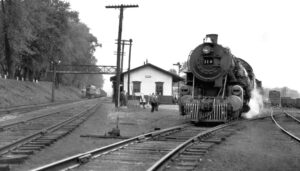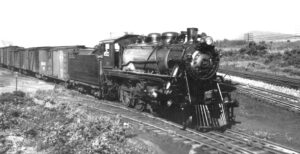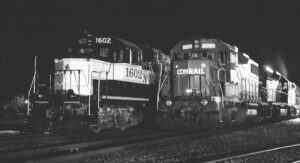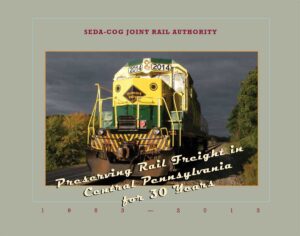IN THE BEGINNING
 Rail line preservation in Central Pennsylvania has been implemented by the SEDA-COG Joint Rail Authority. The Authority was formed in July 1983, through the SEDA Council of Governments Board of Directors to pursue a strategy resulting in the public ownership of rail lines which Conrail had decided to abandon. The seven-county (Centre, Clinton, Columbia, Lycoming, Montour, Northumberland and Union) municipal authority specifically seeks to preserve service to rail-dependant industries through shortline rail operations.
Rail line preservation in Central Pennsylvania has been implemented by the SEDA-COG Joint Rail Authority. The Authority was formed in July 1983, through the SEDA Council of Governments Board of Directors to pursue a strategy resulting in the public ownership of rail lines which Conrail had decided to abandon. The seven-county (Centre, Clinton, Columbia, Lycoming, Montour, Northumberland and Union) municipal authority specifically seeks to preserve service to rail-dependant industries through shortline rail operations.
In 1984, the Rail Authority purchased 82 miles of Conrail lines serving 22 industries. The goal was to preserve not only rail service, but also the 3000 jobs provided by the affected industries. Funding sources at the federal, state and local levels were utilized to develop the project. The $4.1 million needed to acquire and rehabilitate the lines was provided by the U.S. Economic Development Administration, Federal Railroad Administration, Commonwealth of Pennsylvania, Centre County Commissioners, Columbia County Industrial Development Authority, and most importantly, the rail-dependant industries. Over $400,000 of the total project cost was contributed locally. The lines were renamed the North Shore and Nittany & Bald Eagle Railroads.
Since the acquisition and rehabilitation of these two railroads, the Authority has addressed other rail preserrvation situations. In late 1985, the Shamokin area of southern Northumberland County learned Conrail would abandon lines in their community. The affected parties called upoin the Authority for assistance; efforts went forward to assemble a financial package to fund the acquisition and rehabilitation of the Shamokin Cluster (33 miles). The project had many ups and downs, but finally, in mid-1987, the Commonwealth, through its Capital Budget, made a commitment to provide most of the funding to acquire these lines and preserve service to six industries. Significantly, contributions to match the state funding were secured from the rail users, area municipalities, Northumberland County Commissioners and the county industrial development authority. The lines, now known as the Shamokin Valley Railroad, were ultimately acquired in December 1989.
Concurrent with the effort to secure funding for the Shamokin lines, the Authority recognized the need to expand the Nittany and Bald Eagle Railroad to include the Bald Eagle Branch from Milesburg to Mill Hall. This connection allows for shipments to the north and to the northwest from Centre County industries. This acquisition provided for an interchange with Conrail at Lock Haven in addition to the long established one at Vail near Tyrone.
 In July 1935, the Susquehanna and New York Railroad’s daily mixed freight and passenger train leaves Newberry Yard in Williamsport for Towanda. The S & NY was abandoned in 1941, however, their yard trackage in Newberry was retained and is now used by the Lycoming Valley Railroad. Newberry Yard was purchased by the Joint Rail Authority in 1996.
In July 1935, the Susquehanna and New York Railroad’s daily mixed freight and passenger train leaves Newberry Yard in Williamsport for Towanda. The S & NY was abandoned in 1941, however, their yard trackage in Newberry was retained and is now used by the Lycoming Valley Railroad. Newberry Yard was purchased by the Joint Rail Authority in 1996.
RECENT EVENTS
During the 1990’s, in response to new economic pressures, many companies were forced to re-evaluate their operational philosophies and priorities. The railroad industry was no exception. The terms “downsize” and “streamline” were the new buzz words of the 1990’s. Motivated by the realization of increased profits, many railroads “downsized” while many railroads merged. Downsizing often meant selling lines that produced little or no profit.
In January of 1996, Conrail announced it was putting up for sale 1,800 miles of rail lines some of which were within the JRA region. Some of these lines, namely Conrail’s Williamsport Cluster, had extremely high traffic while others such as Conrail’s Lewistown Cluster, had very low amounts of traffic. Both clusters however were strategic to the economic health of the region and as such, the JRA acquired these lines from Conrail in August of 1996 so as to guarantee rail service to the rail dependant industries along these lines.
 On October 15, 1996, Conrail and CSX surprised the railroad industry by agreeing to a strategic merger. Subsequent to that date, Norfolk Southern (NS) also announced its intentions to purchase all or part of Conrail. By March 1997, CSX announced it would purchase all of Conrail and that CSX would sell some of Conrail’s former lines to NS. During March 1997, CSX announced that it would sell NS Conrail’s former Chicago-Pittsburgh-Philadelphia line and the Buffalo-Harrisburg line, both of which lie within the JRA’s region.
On October 15, 1996, Conrail and CSX surprised the railroad industry by agreeing to a strategic merger. Subsequent to that date, Norfolk Southern (NS) also announced its intentions to purchase all or part of Conrail. By March 1997, CSX announced it would purchase all of Conrail and that CSX would sell some of Conrail’s former lines to NS. During March 1997, CSX announced that it would sell NS Conrail’s former Chicago-Pittsburgh-Philadelphia line and the Buffalo-Harrisburg line, both of which lie within the JRA’s region.
What does all of this mean to the JRA and its customers? Hopefully access to not only NS but CSX in Harrisburg and the St. Lawrence and Hudson in Sunbury. It is also anticipated that the JRA’s customers will enjoy better service and reduced rates.
